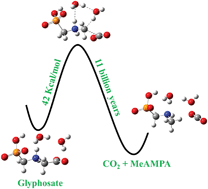On the degradation pathway of glyphosate and glycine†
Abstract
The degradation in water of the most widespread herbicide, glyphosate, is still under debate. Experimental disagreements on this process exist and there are only a few theoretical studies to support any conclusions. Moreover, the relationship between glyphosate and glycine is underestimated. Besides the structural similarity, glycine is a product of glyphosate degradation; hence, their studies are complementary. In this study, two mechanisms for the decomposition of the glyphosate molecule and glycine molecule in water are proposed. These mechanisms were explored by using quantum mechanical calculations. A combined microsolvation/PCM approach was employed to find and characterize their transition states, by which the reaction pathways were determined via the IRC method. The results have shown that the degradation processes might occur via a C–C bond cleavage, through a concerted mechanism, whereby the proton transfers and the CO2 detachments occur simultaneously. The second mechanism had two consecutive steps, a decarboxylation followed by the proton transfers. The water molecules served as a conduit for the proton transfers, away from the amine group (or the phosphonate, glyphosate case). Their function was to assist the reactions in a water-mediated decarboxylation. In these particular cases, the free energy of activation was 42.68 and 42.28 kcal mol−1 for the glycine structure and the glyphosate structure, respectively. These results agreed with the photodegradation and thermodegradation of glyphosate, as well as with the spontaneous decarboxylation of glycine. A concerted mechanism might be expected to yield C–P and C–N bond cleavages in the glyphosate molecule.



 Please wait while we load your content...
Please wait while we load your content...